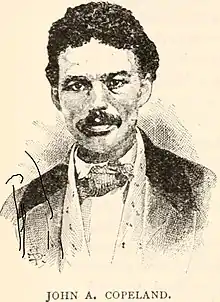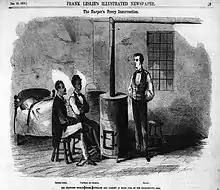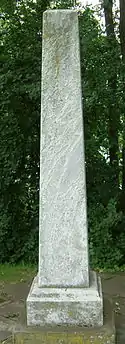John Anthony Copeland Jr.
John Anthony Copeland Jr. (1834–1859) was born a free black in Raleigh, North Carolina. In 1843, when he was a child, his family moved north to Oberlin, Ohio, where he later attended Oberlin College's preparatory (high school) division. He became involved in abolitionist and antislavery activities, and was a highly visible leader in the successful Oberlin-Wellington Rescue of 1858.[1] Copeland joined John Brown's raid on Harpers Ferry; other than Brown, he was the only one of John Brown's raiders that was at all well known.[2] He was captured and convicted of murder and conspiracy to incite slaves to rebellion. He was hanged on December 16, 1859. There were 1,600 spectators.[3] His family tried but failed to recover his body, which was taken by medical students for dissection.
John Anthony Copeland Jr. | |
|---|---|
 John Copeland in 1859, drawing from a newspaper, likely made during his trial | |
| Born | 1834 Raleigh, North Carolina, United States |
| Died | December 16, 1859 (aged 24–25) |
| Cause of death | Hanging |
| Education | Oberlin Collegiate Institute (preparatory division) |
| Known for | Oberlin-Wellington Rescue Raid on Harpers Ferry |
Life
Copeland's parents were John Anthony Copeland, who was born into slavery in 1808, near Raleigh, North Carolina, and Delilah Evans, born a free black in 1809. Copeland Sr. was emancipated as a boy about 1815. As a young man, he married Evans and they lived near Hillsborough, North Carolina, until 1843, when the family fled racial persecution, first to Cincinnati, Ohio, and then to Oberlin. Some of his wife's brothers and their families also settled there. The Copelands lived on the southeast corner of Professor and Morgan Streets.[4]
The son became a carpenter and briefly attended the preparatory division of Oberlin College. His high quality of literacy and self-expression was demonstrated by later letters to his family (see below). According to Ralph Plumb, he was well-educated.[5] He was also described as "east-going, ingratiating, and assimilated.[6] As a young man, he became involved in the Oberlin Anti-Slavery Society.[7]
In 1859, in reporting on the raid, a Dayton newspaper reported that Copeland "has been long a resident of our goodly city."[8]
Anti-slavery activities
Together with his maternal uncles, Henry and Wilson Bruce Evans, in September, 1858, Copeland was a leader of the thirty-seven men involved in the incident known as the Oberlin-Wellington Rescue, freeing John Price, a runaway slave who had been captured and held by authorities under the 1850 Fugitive Slave Act. The men freed the slave and helped him escape to Canada. Copeland was indicted but escaped arrest, and was himself a fugitive at the time he joined John Brown's team.[1]:1794
In September 1859 Copeland was recruited to participate in John Brown's failed raid on Harpers Ferry by his uncle and fellow raider, Lewis Sheridan Leary. Copeland's role in the Harpers Ferry assault was to seize control of Hall's Rifle Works, along with John Henry Kagi, a white raider. Kagi and several others were killed while trying to escape from the Rifle Works by swimming across the Shenandoah River. Copeland was captured alive, taken in the middle of the river.

Copeland, Brown, and five others were held for trial by the state of Virginia. He was also visited by marshals seeking him for the Wellington rescue indictment.[1]:1794 At the trial, Copeland was found guilty of murder and conspiracy to incite slaves to rebellion, and sentenced to death by hanging.[9] A charge of treason was dropped, as his attorney, George Sennott, citing the Dred Scott decision, successfully argued that since Copeland was not a citizen under that Supreme Court ruling, he could not commit treason.[1]:1798–1799
Copeland wrote to his family to make meaning from his sacrifice. Six days before his execution, he wrote to his brother, referring to the American Revolution:
And now, brother, for having lent my aid to a general no less brave [than George Washington], and engaged in a cause no less honorable and glorious, I am to suffer death. Washington entered the field to fight for the freedom of the American people—not for the white man alone, but for both black and white. Nor were they white men alone who fought for the freedom of this country. The blood of black men flowed as freely as the blood of white men. Yes, the very first blood that was spilt was that of a negro... But this you know as well as I do, ...the claims which we, as colored men, have on the American people.[10][Notes 1]
Another letter reflected the religious influence of his Oberlin upbringing. In a December 16 letter, Copeland wrote to console his family:
Why should you sorrow? Why should your hearts be racked with grief? Have I not everything to gain and nothing to lose by the change? I fully believe that not only myself but also all three of my poor comrades who are to ascend the same scaffold (a scaffold already made sacred to the cause of freedom, by the death of that great champion of human freedom, Capt. JOHN BROWN) we are prepared to meet our God.[10]
The family allowed the letters to be published in the abolitionist press.[10]
Speaking of Copeland, the trial's prosecuting attorney, Andrew Hunter, said:
From my intercourse with him I regarded him as one of the most respectable prisoners we had. ...He was a copper-colored Negro, behaved himself with as much firmness as any of them, and with far more dignity. If it had been possible to recommend a pardon for any of them, it would have been for this man Copeland, as I regretted as much, if not more, at seeing him executed than any other one of the party.[11]
Death

Copeland was executed at Charles Town, Virginia, on December 16, 1859. On his way to the gallows he reportedly said, "If I am dying for freedom, I could not die for a better cause. I had rather die than be a slave."[12]
His body
There were five Blacks who died in the raid or were executed shortly afterwards. None received a proper burial; two, Shields Green and Copeland, were dissected by medical students, and their remains discarded.
Copeland was the only one of the five whose family—his parents—tried to recover and bury the body. At their request, Oberlin Mayor A. N. Beecher telegraphed Gov. Henry Wise of Virginia to ask for their son's body. Wise replied that as free Blacks they could not enter Virginia, but the body would be given by General Taliaferro to "any white person".[13]
Abolitionists had also written to Governor Wise seeking the bodies of both Copeland and Green; George Stearns, one of Brown's backers, wanted to erect a memorial to them in Auburn Cemetery. Nevertheless, either Wise went back on his word, or he allowed someone else to assume authority,[14] for no sooner than the bodies were in the ground than they were almost immediately dug up and taken to Winchester Medical College, for use by students studying anatomy. The use of criminals' bodies for this purpose was legal.
There are conflicting reports about the white person who tried to help the Copelands recover their son's body. According to a newspaper report, at the parents' request a "pro-slavery man" went from Washington to claim the body, but he was arrested, held 12 hours, and put on the train home.[15] Since all agree there was only one white person involved, one must give preference to the first-person account of Professor James Monroe of Oberlin College, a friend of the Copelands. The professors at the Winchester Medical College were willing to turn the body over to Monroe for burial by the parents, but medical students visited Monroe, told him the body belonged to the students, not the faculty—they were the ones who had dug the bodies up—and warned him of consequences if he persisted, a warning which the professors supported. The students had broken into the dissection room, and stolen and hid the body. Monroe, to his surprise, found instead the body of Green, whom he recognized.[10][16] "We visited the dissecting rooms. The body of Copeland was not there, but I was startled to find the body of another Oberlin neighbor whom I had often met upon our streets, a colored man named Shields Greene."[17]
After Monroe's return in failure, he gave his report to 3,000 mourners at an Oberlin church, with an empty casket on display.[10]:40
Legacy and honors
- On December 25, 1859, a memorial service was held in Oberlin for Copeland, Green, and Lewis Sheridan Leary, who died during the raid.
- A cenotaph was erected in 1865, after the Civil War, in Westwood Cemetery to honor the three "citizens of Oberlin." The monument was moved in 1977 to Martin Luther King Jr. Park on Vine Street in Oberlin.[18][19] The inscription reads:
- "These colored citizens of Oberlin, the heroic associates of the immortal John Brown, gave their lives for the slave. Et nunc servitudo etiam mortua est, laus deo. (And now slavery is finally dead, thanks be to God.)
- S. Green died at Charleston, Va., Dec. 16, 1859, age 23 years.
- J. A. Copeland died at Charleston, Va., Dec. 16, 1859, age 25 years.
- L. S. Leary died at Harper's Ferry, Va., Oct 20, 1859, age 24 years."
Notes
- Copeland was referring to Crispus Attucks, an African American in Boston and the first person killed in the American Revolution.
See also
References
- Lubet, Steven (June 1, 2013). "Execution in Virginia, 1859: The Trials of Green and Copeland". North Carolina Law Review. 91 (5): 1785–1815.
- "The executions at Charlestown [sic]". Pittsburgh Post. December 17, 1859. p. 1. Archived from the original on 2020-10-16. Retrieved 2020-10-16.
- Brandt, Nat (1990). The town that started the Civil War. Syracuse University Press. pp. 118. ISBN 081560243X.
- Plumb, Ralph (April 22, 1888). "John Brown's raid. Congressman Plumb Tells the Story of the Oberlin Rescuers, of Who He Was One". St. Louis Globe-Democrat (St. Louis, Missouri). p. 32 – via newspapers.com.
- Story, Ronald (June 1975). "Review: Blacks, Brown, and Blood: The Hourglass". Reviews in American History. 3 (2): 213–218, at pp. 214–215. JSTOR 2701224.
- "Constitution of the Oberlin Anti-Slavery Society". Oberlin.edu. Retrieved 7 July 2020.
- "The Journal vs. Vallandingham". Daily Empire (Dayton, Ohio). October 25, 1859. p. 1.
- Steven Lubet, The "Colored Hero" of Harper's Ferry: John Anthony Copeland and the War Against Slavery (Cambridge University Press, 2015) p.181.
- Franny Nudelman, John Brown's Body: Slavery, Violence, & the Culture of War, Chapel Hill: University of North Carolina Press, 2004, pp. 40-45 and 66-69, accessed 17 January 2011
- Hunter, John Brown's Raid. Quoted in Du Bois, William Edward Burghardt (1909). John Brown, p. 281. George W. Jacobs & Company.
- Smith, Robert C. (2003). Encyclopedia of African-American Politics, p. 50. Facts on File, Inc.
- "(Letter to the editor)". The Liberator (Boston, Massachusetts). January 6, 1860. p. 3 – via newspapers.com.
- Finkleman, Paul (1995). "Manufacturing Martyrdom: The Antislavery Response to John Brown's Raid". In Finkleman, Paul (ed.). His Soul Goes Marching On. Responses to John Brown and the Harpers Ferry Raid. Charlottesville, Virginia: University Press of Virginia. pp. 41–66, at p. 49. ISBN 0813915368.
- "(Untitled)". Cleveland Daily Leader (Cleveland, Ohio). December 22, 1859. p. 2 – via newspapers.com.
- "John Copeland: A Hero of Harpers Ferry" Archived 2007-09-28 at the Wayback Machine, WCPN Radio, Aired February 21, 2001 (text and audio versions) accessed May 20, 2007.
- Monroe, James (1897). "A journey to Virginia in December 1859". Oberlin Thursday Lectures and Essays. Oberlin, Ohio: Edward J. Goodrich. pp. 158–184, at pp. 174–175.
- "Monument to the Oberlinians Who Participated in John Brown's Raid On Harpers Ferry", Oberlin University, accessed May 21, 2007
- 41.289°N 82.216°W
Further reading
- Abzug, Robert, Cosmos Crumbling: American Reform and the Religious Imagination. Oxford University Press, 1994.
- Altman, Susan, Extraordinary Black Americans. Children Press, 1989.
- Barrett, Tracy, Harpers Ferry: the story of John Brown's raid. Millbrook Press, 1994.
- Hinton, Richard J. (1894). John Brown and his men. Funk and Wagnalls. pp. 751.
- Copeland, John A., Copeland Letters. See The Letters of John A. Copeland
- Glaser, Jason, John Brown Raid on Harpers Ferry. Capstone Press, 2006.
- Lawson, John D. (1916). "The Trial of John Anthony Copeland and Shields Green for Murder, Charlestown, Virginia, 1859". American State Trials : A collection of the important and interesting criminal trials which have taken place in the United States from the beginning of our government to the present day. 6. St. Louis: Thomas Law Books. pp. 808–813.